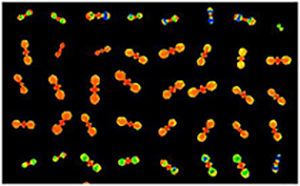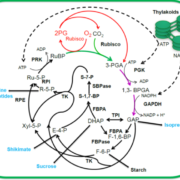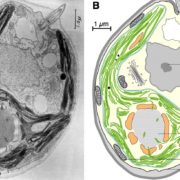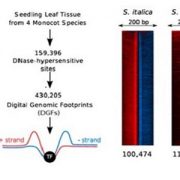BASS Fishing: Genetic Screen Uncovers a New Transporter in Photorespiration
South et al. discover a new transporter involved in photorespiration http://www.plantcell.org/content/29/4/808.abstract.
Photosynthesis uses solar energy to convert carbon dioxide in the atmosphere into sugars that provide the energy and chemical building blocks for plant growth. A key enzyme in photosynthesis is Ribulose bisphosphate carboxylase/oxygenase, known as Rubisco. As implied by the name, Rubisco is a dual function enzyme: it is both a carboxylase and an oxygenase, which means that sometimes it acts on oxygen instead of carbon dioxide. However, the reaction with oxygen produces the molecule glycolate that cannot be directly converted to sugar and is toxic to plants. That Rubisco makes such a “mistake” is a consequence of the similar chemical structures of carbon dioxide and oxygen and the fact that Rubisco evolved at a time when there was no oxygen in the atmosphere and thus no need to distinguish between them.
 The energy-intensive process called photorespiration allows plants to remove toxic glycolate from the cell and recycle a portion of the carbon back to carbon dioxide. In today’s oxygen-rich atmosphere, photorespiration reduces the efficiency of photosynthesis – including that of crop plants – by anywhere from 15-50% depending on growing conditions. In the U.S. for example, photorespiration reduces the output of crops like wheat and soybeans by an estimated 150 trillion calories/year.
The energy-intensive process called photorespiration allows plants to remove toxic glycolate from the cell and recycle a portion of the carbon back to carbon dioxide. In today’s oxygen-rich atmosphere, photorespiration reduces the efficiency of photosynthesis – including that of crop plants – by anywhere from 15-50% depending on growing conditions. In the U.S. for example, photorespiration reduces the output of crops like wheat and soybeans by an estimated 150 trillion calories/year.
Photorespiration is a complex process that involves reactions in three different organelles within the plant cell. This requires numerous transporter proteins to shuttle different molecules around the cell and in and out of the various organelles. At least 25 transport steps are involved, but to date, only a few transporter proteins have been identified.
South et al. conducted a genetic screen using the model plant Arabidopsis thaliana to search for transporters that function in photorespiration. This involved first identifying candidate transporter proteins from chloroplast proteomic studies, and then screening a mutagenized population for mutations in the corresponding genes, specifically searching for mutants that also show a photorespiration abnormality of reduced photosynthetic efficiency – easily visualized using a simple technique for detecting chlorophyll fluorescence. Using this elegant screen, the authors identified a mutant of a transporter protein of previously unknown function called BASS6. Further biochemical analysis showed that BASS6 is a chloroplast-localized glycolate transporter necessary for photorespiration.
This finding provides researchers an additional tool to study photorespiration and further our understanding of how molecules are moved around the cell during this complex process. The ultimate goal is to better understand photorespiration in order to develop strategies to improve photosynthetic efficiency and crop productivity.
South, P.F., Walker, B.J., Cavanagh, A.P., Rolland, V., Badger, M., and Ort, D.R. (2017). Bile Acid Sodium Symporter BASS6 Can Transport Glycolate and Is Involved in Photorespiratory Metabolism in Arabidopsis thaliana. Plant Cell 29: 808-823.










Leave a Reply
Want to join the discussion?Feel free to contribute!